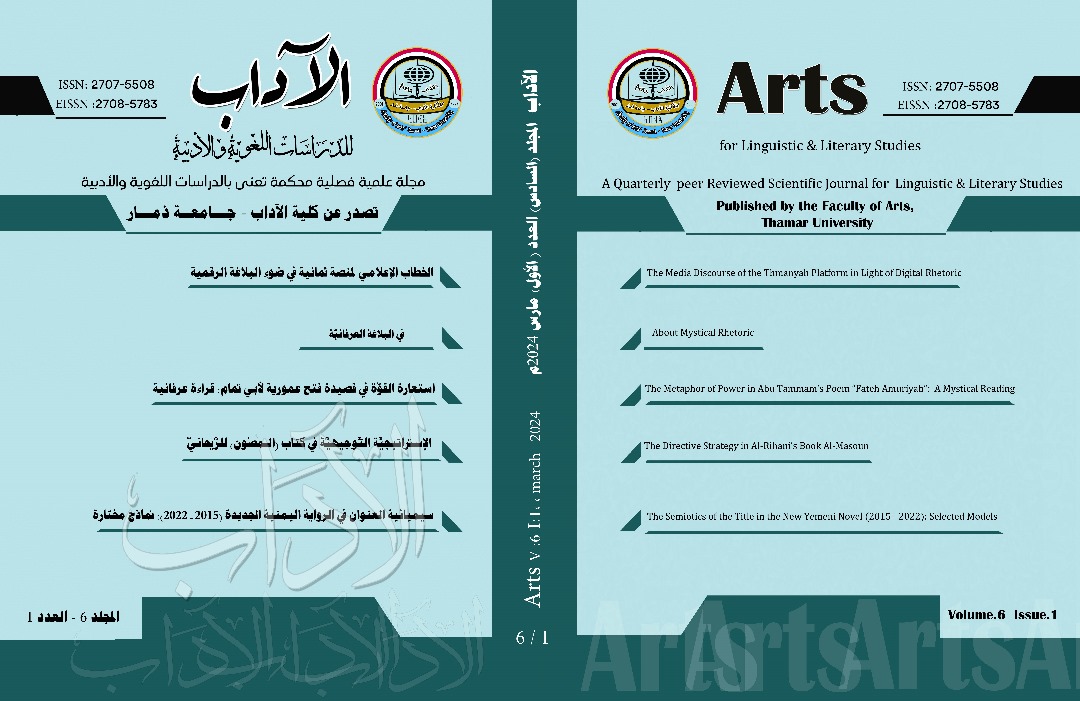Hafeth’s Poetic Language between Simplicity and Magnificence
DOI:
https://doi.org/10.53286/arts.v6i1.1788Keywords:
Verbal Simplicity, Stylistic Magnificence, Homeland Issues, Artistic CharacteristicsAbstract
This research aims to reveal the artistic characteristics in Hafeth Ibrahim’s poetry to reach the goals and objectives that reveal the problem of the intersection of opinion between the simplicity and magnificence of his poetic style. The research was divided into an introduction and two sections. The first section was entitled: Verbal Simplicity in the Poetry of Hafeth Ibrahim, while the second section was entitled: Stylistic Magnificence in the Poetry of Hafeth Ibrahim. Then the research concluded that the circumstances of life are the main driver of Hafeth Ibrahim’s orientations and had a great impact on the conflict of opinion between the magnificence of his style and its simplicity. He also intended for his poetry to be more in touch with the public and even the common Egyptian people. Rather, he was tireless in his attempts to make his poetry the best translation of the contemporary living situation, and even a tool for expressing the issues of his country. This is what the researcher believes is the main reason for adopting the simple poetic language that reaches the common people of his country.
Downloads
References
إبراهيم، محمد حافظ. (1987). ديوانه، الهيئة المصرية للكتاب.
إبراهيم، محمد حافظ. (2012). الأعمال الكاملة: الديوان، مؤسسة هنداوي للتعليم والثقافة.
بدير، حلمي. (1980). شعر الوجدان عند حافظ و شوقي، مجلة فصول، (2)، 231-243.
الجمعة، عبد الله صالح. (2008). أيتام غيروا مجرى التاريخ (ط.2). العبيكان.
الجميعي، عبد المنعم إبراهيم. (2012). شاعر النيل حافظ إبراهيم، سلسلة رواد التنوير، الهيئة العامة للاستعلامات.
حبيب، عبد الرحمن. (2021). الإبداع الأول.. حافظ إبراهيم ينشر أشعاره الأولى على أجزاء، اليوم السابع. https://www.youm7.com/story/2021/9/14
حسين، طه. (1958). حافظ و شوقي (ط.4). مكتبة الخانجي.
الحمداني، أبو فراس. (1944). ديوانه، (سامي الدهان، تحقيق)، المعهد الفرنسي بدمشق للدراسات العربية.
السيد، فؤاد صالح. (2015). أعظم الأحداث المعاصرة (ط.1). مكتبة حسن العصرية.
شوشة، فاروق. (2011). حافظ إبراهيم أكثر شعراء جيله منافسه لشوقى، اليوم السابع. https://www.youm7.com/story/2011/4/11
ضيف، شوقي. (1980). حافظ وشوقي وزعامة مصر الأدبية، مجلة فصول، (2)، 227-243.
عياد، شكري. (1980). قراءة أسلوبية لشعر حافظ، مجلة فصول، (2)، 210-217.
القشطيني، خالد. (1438). حافظ إبراهيم و الشاعر المجهور، جريدة الشرق الأوسط، 13954.
كشاورز، حبيب. (2018). الالتزام وأثره في العاطفة الشعرية في عصر النهضة، حافظ إبراهيم و أحمد شوقي نموذجا، مجلة اللغة العربية وآدابها، 14(3)، 495-516.
المازني، إبراهيم عبد القادر. (2012). شعر حافظ، دار هنداوي.
نشاوي، نسيب. (1984). مدخل إلى دراسة المدارس الأدبية في الشعر المعاصر، ديوان المطبوعات الجامعية.
Reference
Ibrāhīm, Muḥammad Ḥāfiẓ. (1987). Dīwānoh, al-Hayʼah al-Miṣrīyah lil-Kitāb, (in Arabic).
Ibrāhīm, Muḥammad Ḥāfiẓ. (2012). al-Aʻmāl al-kāmilah : al-Dīwān, Muʼassasat Hindāwī lil-taʻlīm & al-Thaqāfah, (in Arabic).
Budayr, Ḥilmī. (1980). Shiʻr al-wijdān ʻinda Ḥāfiẓ & Shawqī, Majallat Fuṣūl, (2), 231-243, (in Arabic).
al-Jumʻah, ʻAbd Allāh Ṣāliḥ. (2008). Aytām ghayyarū majrá al-tārīkh (2nd ed.). al-ʻUbaykān, (in Arabic).
al-Jumayʻī, ʻAbd al-Munʻim Ibrāhīm. (2012). Shāʻir al-Nīl Ḥāfiẓ Ibrāhīm, Silsilat Rūwād al-Tanwīr, al-Hayʼah al-ʻĀmmah lil-Istiʻlāmāt, (in Arabic).
Ḥabīb, ʻAbd al-Raḥmān. (2021). al-Ibdāʻ al-Awwal .. Ḥāfiẓ Ibrāhīm yunsharu ashʻāruh al-ūlá ʻalá ajzāʼ, al-yawm al-sābiʻhttps://www.youm7.com/story/2021/9/14, (in Arabic).
Ḥusayn, Ṭāhā. (1958). Ḥāfiẓ & Shawqī (4th ed.). Maktabat al-Khānjī, (in Arabic).
al-Ḥamdānī, Abū Firās. (1944). dīwānoh, (Sāmī al-Dahhān, taḥqīq), al-Maʻhad al-Faransī bi-Dimashq lil-Dirāsāt al-ʻArabīyah, (in Arabic).
al-Sayyid, Fuʼād Ṣāliḥ. (2015). Aʻẓam al-aḥdāth al-muʻāṣirah (1st ed.). Maktabat Ḥasan al-ʻAṣrīyah, (in Arabic).
Shūshah, Fārūq. (2011). Ḥāfiẓ Ibrāhīm akthar shuʻarāʼ jīlihi munāfasah li-Shwqī, al-yawm al-sābiʻ, https://www.youm7.com/story/2011/4/11, (in Arabic).
Ḍayf, Shawqī. (1980). Ḥāfiẓ & Shawqī & zʻāmh Miṣr al-adabīyah, Majallat fuṣūl, (2), 227-243, (in Arabic).
ʻAyyād, Shukrī. (1980). Qirāʼah uslūbīyah li-shiʻr Ḥāfiẓ, Majallat fuṣūl, (2), 210-217, (in Arabic).
al-Qishṭaynī, Khālid. (1438). Ḥāfiẓ Ibrāhīm & al-shāʻir al-Majhwr, Jarīdat al-Sharq al-Awsaṭ, 13954, (in Arabic).
Kashāwirz, Ḥabīb. (2018). al-Iltizām & atharuhu fī al-ʻāṭifah al-shiʻrīyah fī ʻaṣr al-Nahḍah, Ḥāfiẓ Ibrāhīm & Aḥmad Shawqī namūdhajan, Majallat al-lughah al-ʻArabīyah & ādābihā, 14 (3), 495-516, (in Arabic).
al-Māzinī, Ibrāhīm ʻAbd al-Qādir. (2012). Shiʻr Ḥāfiẓ, Dār Hindāwī, (in Arabic).
Nashāwī, Nasīb. (1984). Madkhal ilá dirāsah al-Madāris al-adabīyah fī al-shiʻr al-muʻāṣir, Dīwān al-Maṭbūʻāt al-Jāmiʻīyah, (in Arabic).
Downloads
Published
How to Cite
Issue
Section
License

This work is licensed under a Creative Commons Attribution 4.0 International License.
Copyright and Licensing
copyright is retained by the authors. Articles are licensed under an open access Creative Commons CC BY 4.0 license, meaning that anyone may download and read the paper for free. In addition, the article may be reused and quoted provided that the original published version is cited. These conditions allow for maximum use and exposure of the work.


























